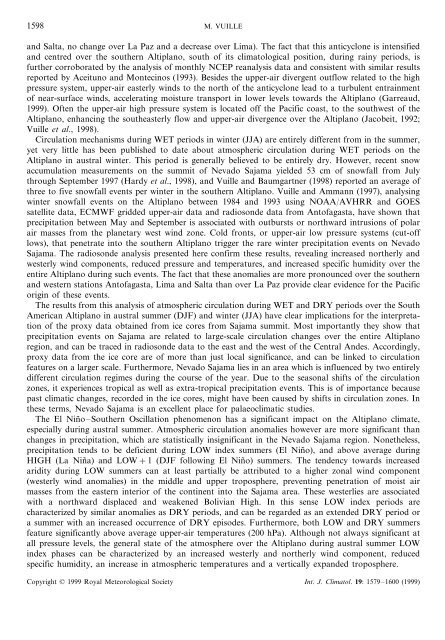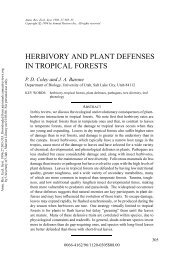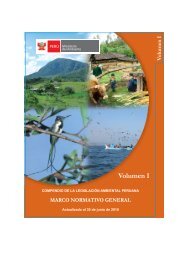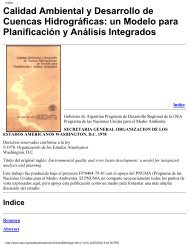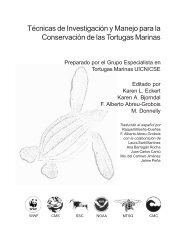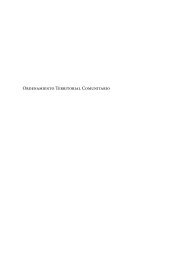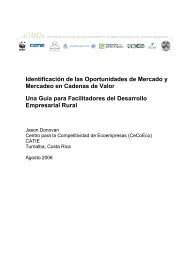Atmospheric circulation over the Bolivian Altiplano during ... - CDAM
Atmospheric circulation over the Bolivian Altiplano during ... - CDAM
Atmospheric circulation over the Bolivian Altiplano during ... - CDAM
You also want an ePaper? Increase the reach of your titles
YUMPU automatically turns print PDFs into web optimized ePapers that Google loves.
1598M. VUILLEand Salta, no change <strong>over</strong> La Paz and a decrease <strong>over</strong> Lima). The fact that this anticyclone is intensifiedand centred <strong>over</strong> <strong>the</strong> sou<strong>the</strong>rn <strong>Altiplano</strong>, south of its climatological position, <strong>during</strong> rainy periods, isfur<strong>the</strong>r corroborated by <strong>the</strong> analysis of monthly NCEP reanalysis data and consistent with similar resultsreported by Aceituno and Montecinos (1993). Besides <strong>the</strong> upper-air divergent outflow related to <strong>the</strong> highpressure system, upper-air easterly winds to <strong>the</strong> north of <strong>the</strong> anticyclone lead to a turbulent entrainmentof near-surface winds, accelerating moisture transport in lower levels towards <strong>the</strong> <strong>Altiplano</strong> (Garreaud,1999). Often <strong>the</strong> upper-air high pressure system is located off <strong>the</strong> Pacific coast, to <strong>the</strong> southwest of <strong>the</strong><strong>Altiplano</strong>, enhancing <strong>the</strong> sou<strong>the</strong>asterly flow and upper-air divergence <strong>over</strong> <strong>the</strong> <strong>Altiplano</strong> (Jacobeit, 1992;Vuille et al., 1998).Circulation mechanisms <strong>during</strong> WET periods in winter (JJA) are entirely different from in <strong>the</strong> summer,yet very little has been published to date about atmospheric <strong>circulation</strong> <strong>during</strong> WET periods on <strong>the</strong><strong>Altiplano</strong> in austral winter. This period is generally believed to be entirely dry. However, recent snowaccumulation measurements on <strong>the</strong> summit of Nevado Sajama yielded 53 cm of snowfall from Julythrough September 1997 (Hardy et al., 1998), and Vuille and Baumgartner (1998) reported an average ofthree to five snowfall events per winter in <strong>the</strong> sou<strong>the</strong>rn <strong>Altiplano</strong>. Vuille and Ammann (1997), analysingwinter snowfall events on <strong>the</strong> <strong>Altiplano</strong> between 1984 and 1993 using NOAA/AVHRR and GOESsatellite data, ECMWF gridded upper-air data and radiosonde data from Antofagasta, have shown thatprecipitation between May and September is associated with outbursts or northward intrusions of polarair masses from <strong>the</strong> planetary west wind zone. Cold fronts, or upper-air low pressure systems (cut-offlows), that penetrate into <strong>the</strong> sou<strong>the</strong>rn <strong>Altiplano</strong> trigger <strong>the</strong> rare winter precipitation events on NevadoSajama. The radiosonde analysis presented here confirm <strong>the</strong>se results, revealing increased nor<strong>the</strong>rly andwesterly wind components, reduced pressure and temperatures, and increased specific humidity <strong>over</strong> <strong>the</strong>entire <strong>Altiplano</strong> <strong>during</strong> such events. The fact that <strong>the</strong>se anomalies are more pronounced <strong>over</strong> <strong>the</strong> sou<strong>the</strong>rnand western stations Antofagasta, Lima and Salta than <strong>over</strong> La Paz provide clear evidence for <strong>the</strong> Pacificorigin of <strong>the</strong>se events.The results from this analysis of atmospheric <strong>circulation</strong> <strong>during</strong> WET and DRY periods <strong>over</strong> <strong>the</strong> SouthAmerican <strong>Altiplano</strong> in austral summer (DJF) and winter (JJA) have clear implications for <strong>the</strong> interpretationof <strong>the</strong> proxy data obtained from ice cores from Sajama summit. Most importantly <strong>the</strong>y show thatprecipitation events on Sajama are related to large-scale <strong>circulation</strong> changes <strong>over</strong> <strong>the</strong> entire <strong>Altiplano</strong>region, and can be traced in radiosonde data to <strong>the</strong> east and <strong>the</strong> west of <strong>the</strong> Central Andes. Accordingly,proxy data from <strong>the</strong> ice core are of more than just local significance, and can be linked to <strong>circulation</strong>features on a larger scale. Fur<strong>the</strong>rmore, Nevado Sajama lies in an area which is influenced by two entirelydifferent <strong>circulation</strong> regimes <strong>during</strong> <strong>the</strong> course of <strong>the</strong> year. Due to <strong>the</strong> seasonal shifts of <strong>the</strong> <strong>circulation</strong>zones, it experiences tropical as well as extra-tropical precipitation events. This is of importance becausepast climatic changes, recorded in <strong>the</strong> ice cores, might have been caused by shifts in <strong>circulation</strong> zones. In<strong>the</strong>se terms, Nevado Sajama is an excellent place for palaeoclimatic studies.The El Niño–Sou<strong>the</strong>rn Oscillation phenomenon has a significant impact on <strong>the</strong> <strong>Altiplano</strong> climate,especially <strong>during</strong> austral summer. <strong>Atmospheric</strong> <strong>circulation</strong> anomalies however are more significant thanchanges in precipitation, which are statistically insignificant in <strong>the</strong> Nevado Sajama region. None<strong>the</strong>less,precipitation tends to be deficient <strong>during</strong> LOW index summers (El Niño), and above average <strong>during</strong>HIGH (La Niña) and LOW+1 (DJF following El Niño) summers. The tendency towards increasedaridity <strong>during</strong> LOW summers can at least partially be attributed to a higher zonal wind component(westerly wind anomalies) in <strong>the</strong> middle and upper troposphere, preventing penetration of moist airmasses from <strong>the</strong> eastern interior of <strong>the</strong> continent into <strong>the</strong> Sajama area. These westerlies are associatedwith a northward displaced and weakened <strong>Bolivian</strong> High. In this sense LOW index periods arecharacterized by similar anomalies as DRY periods, and can be regarded as an extended DRY period ora summer with an increased occurrence of DRY episodes. Fur<strong>the</strong>rmore, both LOW and DRY summersfeature significantly above average upper-air temperatures (200 hPa). Although not always significant atall pressure levels, <strong>the</strong> general state of <strong>the</strong> atmosphere <strong>over</strong> <strong>the</strong> <strong>Altiplano</strong> <strong>during</strong> austral summer LOWindex phases can be characterized by an increased westerly and nor<strong>the</strong>rly wind component, reducedspecific humidity, an increase in atmospheric temperatures and a vertically expanded troposphere.Copyright © 1999 Royal Meteorological Society Int. J. Climatol. 19: 1579–1600 (1999)


